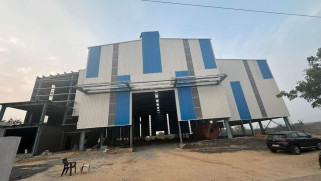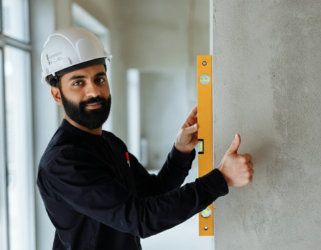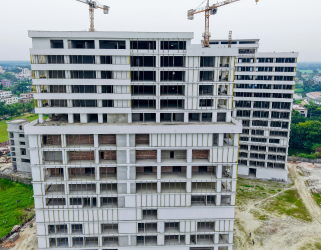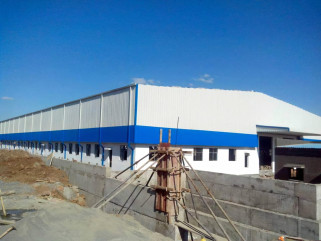PEB vs Traditional Construction: Why Composite Methods Are Leading the Way

The construction industry has always been defined by innovation, striving to find better, faster, and more cost-effective ways to create functional structures. Over the years, the shift towards Pre-Engineered Buildings (PEB) and composite construction methods has revolutionised the sector, offering clear advantages over traditional construction techniques. From reduced construction time to long-term sustainability, it's evident why these modern methods are gaining traction globally.
This blog will explore the difference between PEB and conventional construction, highlight the advantages of composite structures in modern construction, and showcase how organisations like Metrosh are driving this transformation.
What Are Pre-Engineered Buildings (PEB)?
A Pre-Engineered Building (PEB) is a method of construction where building components are designed, fabricated, and assembled off-site before being transported to the construction site for assembly. These buildings are primarily made of steel and are framed structurally for maximum customisation.
Unlike traditional construction methods that rely heavily on on-site activities, PEBs offer a streamlined approach, significantly reducing project timelines.
Understanding Traditional Construction
Traditional construction often relies on materials like reinforced cement concrete (RCC) and bricks, which are assembled almost entirely on-site. While these methods have been used for centuries, they often result in higher material wastage, longer construction durations, and increased labour requirements.
The comparison between steel structures vs RCC buildings becomes more apparent when factors like durability, flexibility, and cost-effectiveness are taken into account.
Differences Between PEB and Conventional Construction
1. Material and Construction Process
- PEB utilises pre-fabricated steel components that are designed and manufactured in a controlled environment. These components are then bolted together on-site, ensuring precision and seamless assembly.
- Traditional construction methods use RCC, which requires manual mixing, framework preparation, and curing processes at the construction site.
2. Time Efficiency
- PEB construction can reduce project completion times by up to 50% since most components are pre-designed and ready for assembly.
- On the other hand, traditional construction is heavily reliant on weather conditions and often delayed by lengthy curing timelines.
3. Cost
- When comparing the PEB vs civil construction cost, PEB buildings typically incur significantly lower expenses. Fewer materials are wasted during the prefabrication stage, and reduced labour needs translate to lower project costs.
- Traditional construction often involves higher material expenses due to inefficiencies and on-site wastage.
4. Customisability
- PEB designs offer unparalleled flexibility, allowing architects and engineers to create structures that meet specific needs.
- Traditional methods are less adaptive, especially when changes are required midway through the construction process.
5. Durability
- Steel structures in composite construction methods are inherently resistant to corrosion, extreme weather, and seismic activity.
- RCC buildings require additional care and reinforcement, increasing maintenance costs over time.
The Rise of Composite Construction Methods
The term composite construction methods refers to combining two or more construction materials to optimise structural benefits. A common example is the use of steel and concrete together, leveraging the tensile strength of steel with the compressive strength of concrete. Here's why these methods are becoming a preferred choice:
1. Weight Reduction
Composite structures are lighter than traditional solid concrete buildings, reducing the burden on foundations and supporting structures.
2. Enhanced Durability
Combining materials like steel and concrete creates structures that are more robust and resistant to wear and tear.
3. Environmental Benefits
By efficiently utilising materials, composite construction reduces waste, contributing to sustainable building practices.
4. Design Flexibility
Composite methods allow engineers to design innovative and complex architectures without compromising structural stability.
Benefits of Pre-Engineered Buildings
PEBs, a key application of composite construction, are set apart by several distinctive advantages:
1. Faster Project Turnaround
The ability to pre-fabricate components in a controlled environment minimises construction delays significantly.
2. Cost Efficiency
Every stage of PEB construction—from manufacturing to assembly—is streamlined for cost control, ensuring minimal wastage and financial savings.
3. Structural Adaptability
PEB buildings are easy to expand, making them ideal for businesses needing scalable solutions.
4. Energy Efficiency
Thanks to superior insulation options, PEB buildings are more energy-efficient than traditional structures, reducing long-term operational costs.
5. Reduced Maintenance
Steel structures are inherently low maintenance compared to RCC or brick buildings, ensuring long-lasting performance even in challenging environments.
Steel Structures vs RCC Buildings
When debating PEB vs traditional construction, the comparison often boils down to steel structures vs RCC buildings. Some key points include:
- Steel is recyclable, making it an eco-friendly option, while RCC generally contributes to construction waste.
- Steel frames allow for design freedom and adaptability, whereas RCC requires extensive modification for design changes.
- Seismic resistance is a major advantage of steel over RCC, as PEB buildings distribute loads effectively in earthquakes.
Why Composite Structures Are Dominating Modern Construction
Composite structures are not limited to commercial projects. They are increasingly being used in residential, industrial, and infrastructure projects to deliver durable, flexible solutions. Part of their appeal lies in their sustainability—a crucial factor as industries strive to reduce their carbon footprints.
Additionally, advances in technology and precision manufacturing have made composite materials more accessible and affordable, further cementing their place in the future of construction.
Choose Metrosh for Your Next Project
The shift towards modern methods like PEB and composite structures is undeniable, offering clear benefits over traditional construction. Whether you’re considering speed, costs, or environmental impact, Pre-Engineered Buildings and composite construction methods consistently outperform.
With a reputation built on quality and reliability, Metrosh is a trusted leader in the manufacturing, supply, and erection of pre-engineered steel buildings, steel girders, foot over bridges (FOB), road over bridges (ROB), and limited height subways (LHS). Partner with Metrosh to experience the future of construction, today.
Our Services
Pre-Engineered Buildings | Civil Construction | Hybrid Constructions | Best Construction Company
FAQs
1. What is the difference between PEB and traditional construction?
PEB (Pre-Engineered Buildings) uses pre-fabricated components that are manufactured off-site and assembled quickly on-site, offering faster construction and cost efficiency. Traditional construction, on the other hand, relies on on-site fabrication using materials like Reinforced Concrete Cement (RCC), making it more time-intensive and less flexible.
2. What are the advantages of PEB over conventional construction methods?
PEBs provide several advantages, including significantly reduced construction time, cost savings, optimized material usage, flexibility in design, and eco-friendliness due to minimal waste.
3. How do composite methods enhance the performance of PEB structures?
Composite methods, which combine steel and concrete, enhance PEB structures by optimizing strength, lowering construction timelines, and improving durability and sustainability for long-term performance.
4. Are PEB structures as durable as traditional buildings?
Yes, PEB structures are highly durable. They offer superior resistance to corrosion, seismic activity, and harsh environmental conditions compared to traditional buildings.
Related Articles

Why Pre-Engineered Buildings Are the Ultimate Cost-Saving Solution?
24 Sep 2025
Strong, Durable, and Long-Lasting: The Structural Superiority of PEBs
23 Sep 2025
Quality Control in Civil Construction: Metrosh Infra’s Standards and Practices
22 Sep 2025
Cost-Efficiency in Hybrid Construction: Balancing Budget and Quality
22 Sep 2025
Building the Future: Metrosh Infra’s Approach to Turnkey Civil Construction
20 Sep 2025


